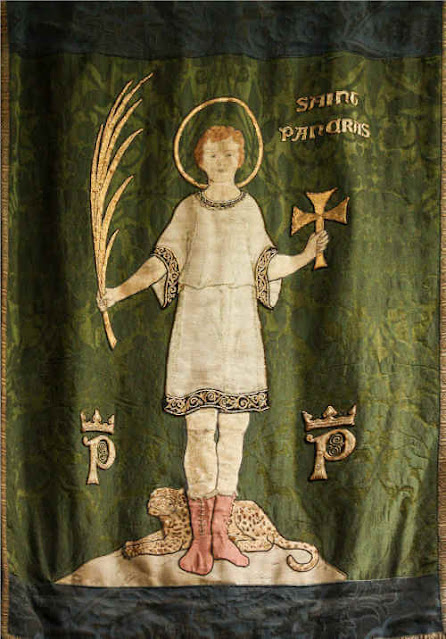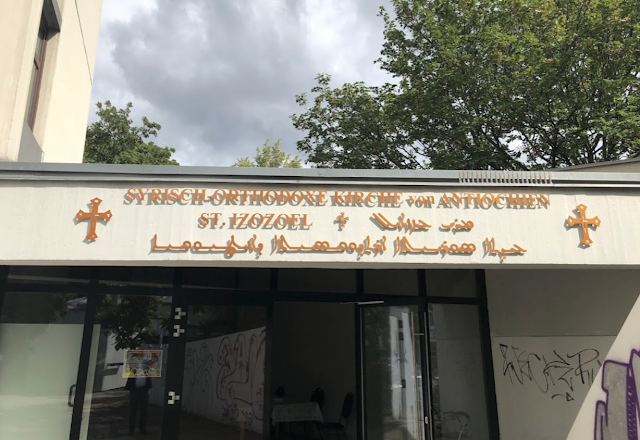St Pancras = St Azazael
Now, you may have heard of St Pancras in terms of place names, particularly if you've been looking at London or England.

Pope Gregory the Great gave impetus to the cult of Pancras, sending Augustine to England carrying relics of that saint and including his legend in Liber in gloria martyrum (for this reason, many English churches are dedicated to Pancras; St Pancras Old Church in London is one of the oldest sites of Christian worship in England).
In Western Christianity he [St Azazael] is known as St. Pancras. It is believed that the King of Northumberland in Great Britain received a portion of saint’s relics and built a church dedicated to the martyr. Additionally, several churches in London and surroundings are in the name of the saint. A well-known Railway station in London, England is named after St. Pancras in his honor. [source]
Why is it important to know about St Pancras?
Because ...
He is also known as ...
St Azazael.
Written also as St Izozoel - or Mor Izozoel - in the Syriac tradition.
But ... as some of you will be quite aware ... his name shall be erased.
The name, Pancras is Greek (Πανκράτιος) and means "the one that holds everything".
Now, I'm still on the trail of digging out HOW's and WHY's St Pancras and St Azazael merged, but I certainly did a double-take to learn that they are, for all intents and purposes, one and the same.
So, let's do a little digging, and see how far I can go in this first sweep. Below is simply a curation of various content that I've found, some of which may be relevant and some of which may be not. However, even the ones that may not, may still hold clues, like stepping stones, that could unearth hidden treasures.
St Azazael is the patron saint of children.
 |
| San Pancrazio by Guercino 1616 Guercino was born as Giovanni Francesco Barbier (1591 - 1666) |
According to tradition, Pancratius (Pancras) was born around 289 AD near Synnada, now Suhut in modern Turkey. His parents were Roman citizens who died when he was young and his uncle Dionysius took him to Rome where they converted to Christianity. During the Diocletian persecution Pancras refused to sacrifice to the Roman gods and was decapitated on 12 May 303 AD. There is dispute over the date. Pancras body was buried in the Catacombs of Rome and his head placed in a reliquary which is today in the Basilica San Pancrazio which was built over the catacomb in the 5th century by Pope Symmachus. Pope Gregory I gave impetus to the cult of St Pancras.
Bede’s Historia records that Gregory saw some fair-haired young Saxon slaves in the Roman market place and was told they were Angles. He said: “Non Angli sed angeli” (not Angles but Angels) and determined to send a Christian mission to their homeland. Whatever the reason, he sent Augustine, prior of the Benedictine monastery of St Andrew in Rome, with relics of St Pancras on a mission to Æthelberht, Anglo-Saxon king of Kent, in 595 AD. It is said that the first church founded by Augustine in England was dedicated to St Pancras.
The dedication of Lewes Priory to the saint is believed to have been derived from that of the earlier church on the site. This small Saxon church is described by Thomas Horsfield in ‘The History and Antiquities of Lewes and Its Vicinity’ as being converted to stone by William de Warenne. St Pancras would have had a special significance for the Normans as Harold Godwinson had sworn support for Duke William on sacred relics. These were said to be relics of St Pancras whom St Gregory of Tours calls the Avenger of Perjuries. Harold’s subsequent defeat was attributed to his oath breaking.
British History Online has this to say about the saint:
In consequence of the early age at which he suffered for the faith, St. Pancras was subsequently regarded as the patron saint of children. "There was then," as Chambers remarks in his "Book of Days," "a certain fitness in dedicating to him the first church in a country which owed its conversion to three children"—alluding, of course, to the fair children whom Gregory saw in the streets of Rome, the sight of whom had moved the Pope to send St. Augustine hither.
"But there was also another and closer link which connected the first church built in England by St. Augustine with St. Pancras, for," adds Mr. Chambers, "the much loved monastery on the Cœlian Mount, which Gregory had founded, and of which Augustine was prior, had been erected on the very estate which had belonged anciently to the family of Pancras."
The festival of St. Pancras is kept, in the Roman Catholic Church, on the 12th of May, under which day his biography will be found in the "Lives of the Saints," by Alban Butler, who tells us that he suffered martyrdom at the early age of fourteen, at Rome, in the year 304.
After being beheaded for the faith, he was buried in the cemetery of Calepodius, which subsequently took his name. His relics are spoken of by Gregory the Great. St. Gregory of Tours calls him the Avenger of Perjuries, and tells us that God openly punished false oaths made before his relics. The church at Rome dedicated to the saint, of which we have spoken above, stands on the spot where he is said to have suffered; in this church his body is still kept.
"England and Italy, France and Spain abound," adds Alban Butler, "in churches bearing his name, in most of which relics of the saint were kept and shown in the ages before the Reformation. The first church consecrated by St. Augustine at Canterbury is said by Mr. Baring Gould, in his "Lives of the Saints," to have been dedicated to St. Pancras.
In art, St. Pancras is always represented as a boy, with a sword uplifted in one hand and a palm-branch in the other; and it may be added that the seal of the parish represents the saint with similar emblems.
There is a magnificent brass of Prior Nelond, at Cowfold, in Sussex, where St. Pancras is represented with a youthful countenance, holding a book and a palm-branch, and treading on a strange figure, supposed to be intended to symbolise his triumphs over the archenemy of mankind, in allusion to the etymology of the saint's name.
The saint figures in Alfred Tennyson's poem of "Harold," where William Duke of Normandy exclaims:
"Lay thou thy hand upon this golden pall;
Behold the jewel of St. Pancratius
Woven into the gold. Swear thou on this."
[source for the above]
St Pancras Old Church
St Pancras Old Church is one of the oldest sites of Christian worship in England.
 |
| St Pancras Old Church |
This name – now only usually used in reference to several buildings and landmarks around the Kings Cross area including churches, a road, hotel and railway stations – was originally that of a separate village.
The village was named for the church in its midst which had been dedicated to St Pancras. The church – which has been dated back to at least the Norman era – is said to have been built on one of the earliest sites of Christian worship in the UK and was dedicated to a Roman-era boy martyr, St Pancras (in Latin, St Pancratius).
Tradition holds that St Pancras was a citizen of Rome who converted to Christianity and was beheaded for his faith during the Diocletian persecution in the early 4th century when aged just 14. When Pope Gregory the Great sent St Augustine on his mission to England in the late 6th century, he sent relics of the saint with him, hence why many English churches are dedicated to St Pancras.
The village which had been based around the church was apparently largely abandoned in the Middle Ages – possibly due to flooding – and the area was only resettled in the late 18th century with the development of Camden Town and Somers Town.
While the church – now known as St Pancras Old Church – was restored in the mid-19th century, a new parish church – known as St Pancras New Church – which built about a kilometre away on Euston Road.
[source]
St Pancras New Church
 |
| Click on this image to go to a much larger version so you can inspect details. |
 |
| Click this link to view the interior 360 degrees. And click this link to go the the New Church's website. |


St Pancras Hospital
St Pancras is also the Patron Saint for the Italian town of San Pancrazio Salentino
.jpeg) |
| The Mor Izozoel (Azozoʾel) church, is an old Syriac Orthodox church located in Altıntaş, Midyat, Mardin Province, Turkey. The church was built in the 7th or 8th century AD, and there are some opinions that indicate that it was founded on an older structure dating back to the 6th century AD. More information is available on this site. |








.jpeg)






